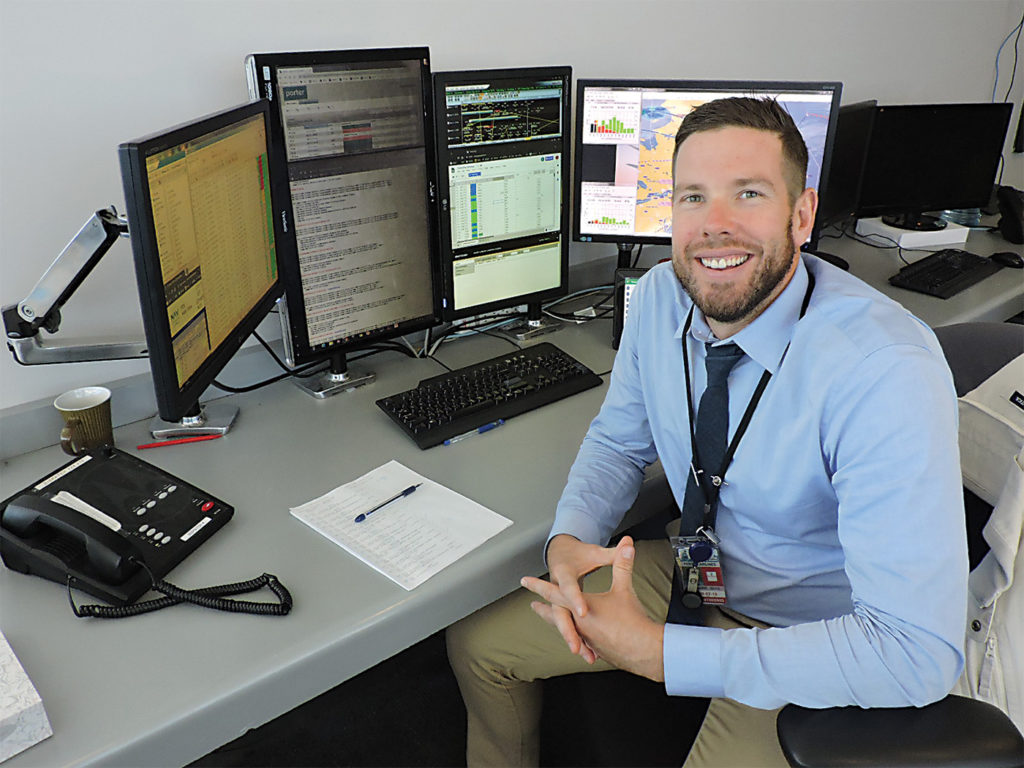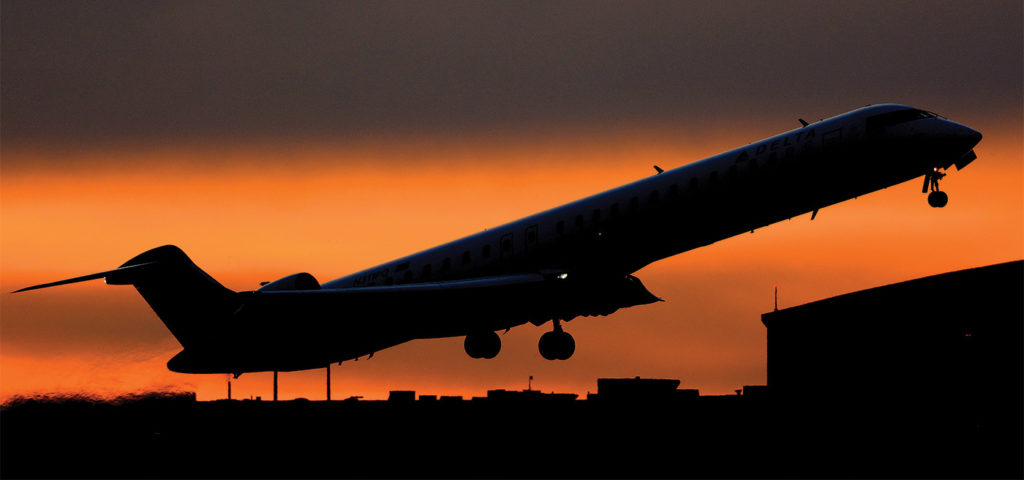Estimated reading time 8 minutes, 46 seconds.
Unless you’re an integral part of the aviation community, whether commercial or corporate, the odds are you’ve never heard of Josh Gelernter, Richard Shehab or Francis Chasteau.

with up to 12 aircraft on a typical shift. Sunwing Photo
There’s no reason why you should know them. Like many in the industry, with the notable exception of pilots, cabin and ground crews, these flight dispatchers work entirely behind the scenes. Critical cogs in a complex machine, they are the men and women who in many cases have “go/no-go” authority on when an aircraft is cleared to leave the terminal or fixed-base operation.
“A lot of people are probably unfamiliar with the role of a dispatcher and their importance in the overall picture at airlines that require dispatchers,” Gelernter explained to Skies from his office at Sunwing Airlines Inc., near Toronto Pearson International Airport (CYYZ).
“Not every airline requires dispatchers; it depends on the type of operation and aircraft, the number of passengers they carry, and where they fly.”
In the busier winter season, Sunwing may operate up to 40 Boeing 737s (800NG and MAX 8 variants) serving the North American and southern charter markets, as well as domestic flights within Canada. Its seasonally-flexible schedule means the airline usually has a roster of 16 to 20 dispatchers.
“At a minimum we’ll have two per shift; but in the winter, when fleet size increases, three or four.”
Each deals with up to 12 aircraft on a typical shift.
Long before a flight is ready to take off or the aircraft has even arrived at the gate, the dispatcher is reviewing information such as weather, airport suitability, aircraft limitations and airspace constraints.

“It is the dispatcher who is responsible for planning how the aircraft will be getting from Point A to Point B, how much fuel will be required, and what is the fallback if the aircraft is for some reason unable to land at their original destination,” explained Gelernter. “The planning includes keeping the flight crew up to date on loads using standard passenger weights, and, when needed, cargo.
“If there’s any difference of opinion between dispatcher and pilot-in-command, our policy/procedure is to involve the on-call manager,” he replied when asked about that potential scenario. “That could be one of various management pilots or office personnel who can mediate the situation after hearing both sides and offer some type of input.”
While rare, differences are dealt with expeditiously. “The closest thing might be when the dispatcher chooses a route for the flight and the pilot wants a different route, or doesn’t want to go as close to weather as the dispatcher wants to plan. That’s something which can be resolved between them. I have no issue, in most cases, with changing the routing if a pilot is not comfortable.”
Dispatchers do not routinely hear air traffic control (ATC) communications, simply because it’s “not within my oversight,” as Gelernter put it, adding that a pilot who has been told something by ATC may inform the dispatcher “to kind of clear it with us or just keep us in the loop.”
Major route changes, however, which could require more fuel, can mean the dispatchers must revise or re-compute the flight plan.
Gelernter, a graduate of Georgian College and Embry-Riddle Aeronautical University,
said there isn’t a specific post-secondary dispatcher program in Canada. Ontario’s Seneca and Georgian colleges have programs which focus on non-flying aviation operations and Gelernter said a majority of his colleagues in the past couple of years have come through those institutions.
Gelernter started in the airline’s maintenance department as a technical librarian before making the move into flight dispatch. His meticulous and detail-oriented nature, combined with a technical knowledge of airline operations, helped him make the transition. He then received Transport Canada mandated training to gain his certification as a flight dispatcher.

Anyone coming in “off the street” must also pass two Transport Canada exams. One focuses on operational topics such as aviation rules/regulations, weight and balance, chart reading, and aircraft systems. The second deals entirely with meteorology. Various classroom and self-study courses can help with preparation.
But passing the exams and being Transport-certified doesn’t guarantee employment, only eligibility.
“Once you have those exams, you could apply to be a dispatcher and if you were hired,” said Gelernter, “the company itself would train you on how it operates and what its policies are.”
That on-the-job training, working with another dispatcher, could last several weeks or months. Then there would be an initial on-site competency test either by a Transport Canada inspector or a Transport Canada-authorized company check dispatcher, after which the individual would be signed off to work autonomously. There is also an annual competency re-check.
Any dispatcher joining Sunwing would first need to complete the company’s in-house training, regardless of their previous experience.
A second set of eyes
The situation isn’t much different at a scheduled carrier, such as Porter Airlines Inc., where Richard Shehab is chief dispatcher.
The carrier operates a fleet of Bombardier Q400 turboprops from its home base at Billy Bishop Toronto City Airport (CYTZ).
Shehab, who came out of Seneca College’s operations program and has been with Porter for nearly seven years, is one of 15 dispatchers. Four work during the day and three at night, because CYTZ has a 23:00-06:45 operations curfew. Shifts overlap to facilitate handovers.

“I did a co-op placement at Air Georgian (a CYYZ-based Air Canada Express partner) as they were transitioning to a 705 operation from a 704 operation, before I came to Porter,” said Shehab.
He explained to Skies that his role is to “formulate, execute and amend the operational flight plan” as required by Canadian Aviation Regulations (CARs), including key fuel considerations, weather analytics, traffic flow into dense markets, airport restrictions such as construction or closures, and aircraft performance.
“When the flight plan is released by the dispatcher, it’s sent to the crew and to ATC simultaneously. They (ATC) get a postage-stamp version, the raw details of the flight. We don’t actually need to talk directly with ATC unless they have some sort of amendment. They may say that we need to fly at a different altitude because of route restrictions, or they may change the route completely to avoid severe weather systems, which is common [when] flying into the United States in summer.”
Shehab said Porter also maintains a “flight watch” by monitoring the route for any factors which might not be apparent to pilots. “We’re essentially a second set of eyes on that flight … and that also involves interaction with ATC in order to get clarification or permissions to make significant deviations during flight.”
Focusing on the details
Then, there are private and business aviation operators.
At Chartright Air Group–it, too, is headquartered at CYYZ, but has facilities in Kitchener, Calgary, Regina, Vancouver and Southern Florida–Francis Chasteau describes himself as a flight co-ordinator and client account manager.
He told Skies that managing nearly four dozen aircraft as diverse as a McDonnell Douglas (Boeing) MD-87, various Bombardier and Gulfstream jets, a Cessna VIP Grand Caravan amphibian, and other smaller platforms brings different challenges to the dispatch role.
 “We micro-manage a smaller set of aircraft on behalf of up to six clients; and while we do dispatching and flight arranging, we go kind of above and beyond by focusing on maintenance, invoicing and personal requirements from start to finish,” said Chasteau.
“We micro-manage a smaller set of aircraft on behalf of up to six clients; and while we do dispatching and flight arranging, we go kind of above and beyond by focusing on maintenance, invoicing and personal requirements from start to finish,” said Chasteau.
Chartright’s seven account managers and eight or nine flight co-ordinators or dispatchers–the titles are used interchangeably–have varied responsibilities in the 24/7 operation. Some handle only three aircraft, while others handle up to 11, depending on clients’ needs or preferences.
Chasteau said he doesn’t have Transport certification because Chartright functions as a CARs Type “C” operational control system. He doesn’t develop flight plans or perform meteorological evaluation; both of those tasks are outsourced to licensed dispatchers at other specialized companies.
“While the account managers tend to be in the office from 9 to 5, we do basically work 24/7 with our flight co-ordinators,” he said. “Our clients call us day or night and we make sure that we’re always available. They may be overseas and it’s two o’clock in the morning here, but we provide arrangements or assistance as needed.”
That sometimes means dealing with aircraft owners’ family members and even pets. “That’s where our operation becomes a little more interesting: special requests.”
Asked whether he and other dispatchers are ever pressed to “make things happen” for demanding clients, Chasteau chuckled before responding diplomatically that “on-time performance is very important because, for example, sometimes an executive has to get to a meeting across the country and five minutes can make or break a deal.”
These clients, understandably, can be assertive and “while it has to be done as quickly as possible,” he said “it’s never at the risk of compromising safety.
“It’s not the least stressful job I’ve had . . . You can have a week where none of your clients are flying, and then you can have another week where you have an AOG [aircraft on ground for maintenance] in the middle of nowhere, and you’re tearing your hair out. It’s really up and down.”

